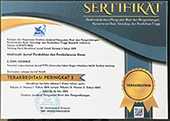MADRASAH SEBAGAI SEKOLAH ISLAMI DAN PELAKSANA PENDIDIKAN INKLUSI
Abstract
The goal of this paper was to study critically why madrasah as an institutional development agen of Islamic education in Indonesia, whith the innovation is that of curriculum oriented in hospitality in approaching the students based on tauhid (the unity of science and religion). The study is carried out in the prespective of Islamic education concept and that of inclusive education.
Through comparative analysis, the study finds five same characteristics of Islamic education and inclusive education: (1) education as a right or duty; (2) education for all; (3) the principle of non-segregation; (4) the holistic view of the pupil; (5) handicap seen in relation to external factors, especially school environment.
Madrasah can be viewed as an application of both the principle of non-segregation and the holistic view of the pupil. The principle of non-segregation is applicated in the process of education with the hospitality to all students: everyone is admitted in accordance with his faculty and potentiality, and receives educational services without discrimination. Moreover, the holistic view of the pupil is applicated in the intended design to meet the faculty of reasoning with that of intuition in the process of learning by the integration the revealed signs from the Qur’an and Sunnah with the cosmic signs (matters of natural and social sciences). The innovation, then, has made the revealed signs the first data as well as the source of values-both are marginalized in the contemporary practice of education.
Other principles are being challenges the madrasah should anticipate in the future. One of them is the developing education human resource, and the way of student recruitment, because they have deferent background.
Keyword: Madrasah, Islamic, Inclusion Education
Through comparative analysis, the study finds five same characteristics of Islamic education and inclusive education: (1) education as a right or duty; (2) education for all; (3) the principle of non-segregation; (4) the holistic view of the pupil; (5) handicap seen in relation to external factors, especially school environment.
Madrasah can be viewed as an application of both the principle of non-segregation and the holistic view of the pupil. The principle of non-segregation is applicated in the process of education with the hospitality to all students: everyone is admitted in accordance with his faculty and potentiality, and receives educational services without discrimination. Moreover, the holistic view of the pupil is applicated in the intended design to meet the faculty of reasoning with that of intuition in the process of learning by the integration the revealed signs from the Qur’an and Sunnah with the cosmic signs (matters of natural and social sciences). The innovation, then, has made the revealed signs the first data as well as the source of values-both are marginalized in the contemporary practice of education.
Other principles are being challenges the madrasah should anticipate in the future. One of them is the developing education human resource, and the way of student recruitment, because they have deferent background.
Keyword: Madrasah, Islamic, Inclusion Education
Keywords
Madrasah; Islamic; Inclusion Education
DOI: https://doi.org/10.18860/jt.v1i1.1854
Copyright (c)





